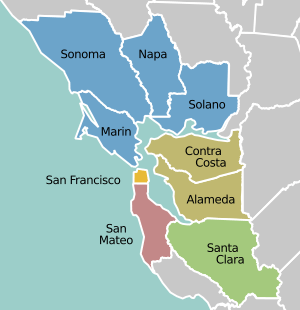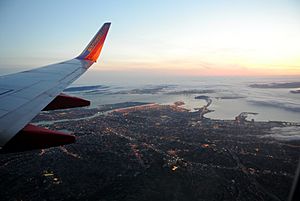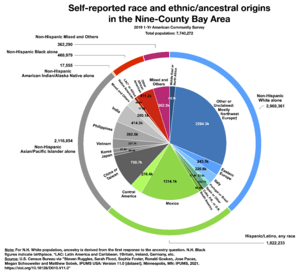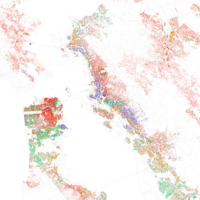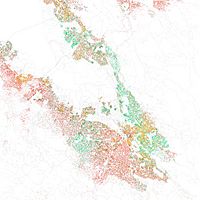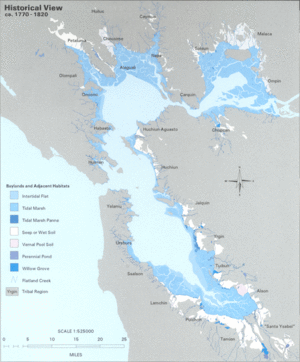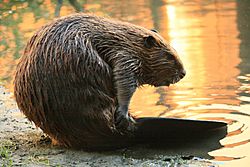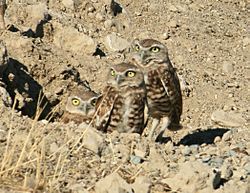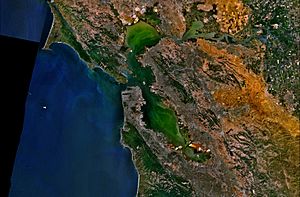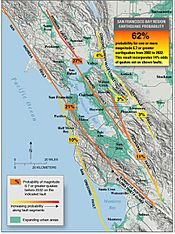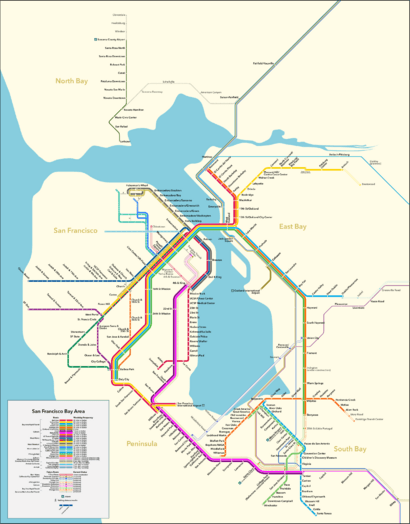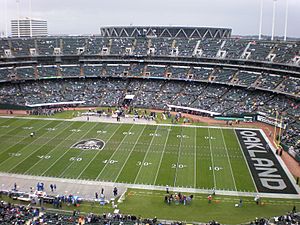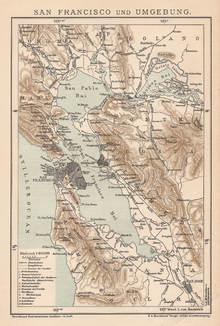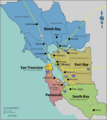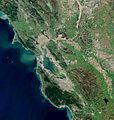San Francisco Bay Area facts for kids
Quick facts for kids
San Francisco Bay Area
|
|
|---|---|
|
Clockwise from top: The Golden Gate Bridge, Muir Woods National Monument, Napa Valley vineyards, Sather Tower at UC Berkeley with the Bay in the background, the Stanford University Oval, the Palo Alto Baylands Nature Preserve, downtown San Jose's skyline, and San Francisco Chinatown with the Bay Bridge in the background
|
|
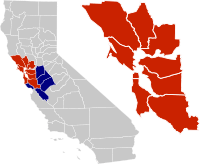
Location of the Bay Area within California.
The nine-county Bay Area. Additional counties in the larger fourteen-county combined statistical area. |
|
| Country | United States |
| State | California |
| Subregions |
|
| Core cities | Oakland San Francisco San Jose |
| Other municipalities | |
| Area | |
| • Nine-county | 6,966 sq mi (18,040 km2) |
| • San Jose-San Francisco-Oakland, CA Combined Statistical Area | 10,191 sq mi (26,390 km2) |
| Highest elevation | 4,360 ft (1,330 m) |
| Lowest elevation | −13 ft (−4.0 m) |
| Population
(2020)
|
|
| • Nine-county | 7.76 million |
| • Nine-county density | 1,115/sq mi (431/km2) |
| • San Jose-San Francisco-Oakland, CA Combined Statistical Area | 9.71 million |
| • San Jose-San Francisco-Oakland, CA Combined Statistical Area density | 953/sq mi (368/km2) |
| Demonym(s) | Bay Arean |
| Time zone | UTC−08:00 (Pacific) |
| • Summer (DST) | UTC−07:00 (PDT) |
| Area codes | 408/669, 415/628, 510/341, 650, 707, 925 |
The San Francisco Bay Area, often referred to as simply the Bay Area, is a populous region surrounding the San Francisco, San Pablo, and Suisun Bay estuaries in Northern California. Although the exact boundaries of the region are variously defined, the Bay Area is defined by the Association of Bay Area Governments to include the nine counties that border the aforementioned estuaries: Alameda, Contra Costa, Marin, Napa, San Mateo, Santa Clara, Solano, Sonoma, and San Francisco. Other definitions may exclude parts of or even entire counties, or expand the boundaries to include neighboring counties that do not border the bay such as Santa Cruz and San Benito (more often included in the Central Coast regions); or San Joaquin, Merced, and Stanislaus (more often included in the Central Valley).
Home to approximately 7.75 million people, Northern California's nine-county Bay Area contains many cities, towns, airports, and associated regional, state, and national parks, connected by a complex multimodal transportation network. The larger federal classification, the combined statistical area of the region which includes fourteen counties, is the second-largest in California (after the Greater Los Angeles area), the fifth-largest in the United States, and the 41st-largest urban area in the world with 9.67 million people. The Bay Area's population is ethnically diverse: roughly three-fifths of the region's residents are Hispanic, Asian, African American, or Pacific Islander (with the other two-fifths being non-Hispanic White American), all of whom have a significant presence throughout the region.
The earliest archaeological evidence of human settlements in the Bay Area dates back to 8000–10,000 BCE (from shell mounds in the Coyote Hills). In 1769, the Bay Area was inhabited by the Ohlone people when a Spanish exploration party led by Gaspar de Portolà entered the Bay – the first documented European visit to the Bay Area. After Mexico established independence from Spain in 1821, the region was briefly controlled by the Mexican government until the United States seized the territory in 1846 during the Mexican–American War. Soon after, discovery of gold in California attracted a flood of treasure seekers, many using ports in the Bay Area as an entry point. During the early years of California's statehood, state legislative business rotated between three locations in the Bay Area before a permanent state capital was established in Sacramento. A major earthquake leveled the city of San Francisco and environs in 1906, but the region quickly rebuilt in time to host the 1915 Panama-Pacific Exposition. During World War II, the Bay Area played a major role in America's war effort in the Asiatic-Pacific Theater, with the San Francisco Port of Embarkation, of which Fort Mason was one of fourteen installations and location of the headquarters, acting as a primary embarkation point for American forces. In 1945, the United Nations Charter was signed in San Francisco, establishing the United Nations, and in 1951, the Treaty of San Francisco re-established peaceful relations between Japan and the Allied Powers. Since then, the Bay Area has experienced numerous political, cultural and artistic movements, developing unique local genres in music and art and establishing itself as a hotbed of progressive politics. Economically, the post-war Bay Area saw huge growth in the financial and technology industries, creating a vibrant and diverse economy with a gross domestic product of over $700 billion, and home to the third-highest concentration of Fortune 500 companies in the United States (as of 2018).
Despite its urban character, the San Francisco Bay is one of California's most ecologically important habitats, providing key ecosystem services such as filtering pollutants and sediments from the rivers and supporting a number of endangered species. In addition, the Bay is known for its stands of coast redwoods, many of which are protected in state and county parks. The region is additionally known for the complexity of its landforms, the result of millions of years of tectonic plate movements. Because the Bay Area is crossed by six major earthquake faults, the region is particularly exposed to hazards presented by large earthquakes. The climate is temperate and generally very mild, and is conducive to outdoor recreational and athletic activities such as hiking, running, and cycling. The Bay Area is host to five professional sports teams and is a cultural center for music, theater, and the arts. It is also host to higher education institutions, including research universities such as Stanford University and the University of California, Berkeley. Home to 101 municipalities and nine counties, governance in the Bay Area involves numerous local and regional actors, often with broad and overlapping responsibilities. Over time, droughts and wildfires have increased in frequency and become less seasonal and more year-round, further straining the region's water security.
Contents
Sub-regions
East Bay
The eastern side of the bay, consisting of Alameda and Contra Costa counties, is known locally as the East Bay. The East Bay can be loosely divided into two regions, the inner East Bay, which adjoins the Bay shoreline, and the outer East Bay, consisting of inland valleys separated from the inner East Bay by hills and mountains.
- The inner East Bay includes the western portions of Alameda and Contra Costa Counties, including the cities of Oakland, Hayward, Fremont, Berkeley, and Richmond, as well as many smaller suburbs such as Alameda, Castro Valley, Newark, Union City, Emeryville, Albany, San Leandro, San Pablo, Crockett, El Sobrante, Pinole, San Lorenzo, Hercules, Rodeo, Piedmont, and El Cerrito. The inner East Bay is more densely populated, with generally older buildings, and a more ethnically diverse population. This region contains the Bay Area's largest seaport, the Port of Oakland, the headquarters of Pixar Animation Studios, and hosts the professional sports franchises the Golden State Warriors, Oakland Raiders, and Oakland Athletics.
- The outer East Bay consists of the eastern portions of Alameda and Contra Costa counties and is divided into 4 distinct areas: Lamorinda, Central Contra Costa County, East Contra Costa County, and the Tri-Valley. The word Lamorinda was coined by combining the names of the cities it includes: Lafayette, Moraga, and Orinda. Walnut Creek is situated east of Lamorinda and north of the San Ramon Valley and, together with Concord, Martinez, and Pleasant Hill comprises Central Contra Costa County. The cities of Antioch, Pittsburg, Brentwood, Oakley and the unincorporated areas surrounding them comprise East Contra Costa County. The Tri-Valley consists of the Amador, the Livermore, and the San Ramon Valleys. Dublin and Pleasanton comprise the Amador Valley, Livermore lies in the Livermore Valley, and the San Ramon Valley consists of Alamo, Danville, Diablo and its namesake, San Ramon. The outer East Bay is connected to the inner East Bay (East/West) by BART, Interstate 580 to the south, and State Routes State Route 4 to the north, and State Route 24 via the Caldecott Tunnel in the center. The outer East Bay's infrastructure was mostly built up after World War II. This area remains largely white demographically, although the Hispanic and Filipino populations have grown significantly over the past 2–3 decades.
North Bay
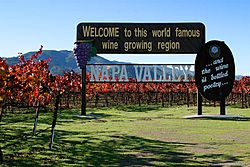
The region north of the Golden Gate Bridge is known locally as the North Bay. This area encompasses Marin County, Sonoma County, Napa County and extends eastward into Solano County. The city of Fairfield, being part of Solano County, is often considered the easternmost city of the North Bay.
With few exceptions, this region is quite affluent: Marin County is ranked as the wealthiest in the state. The North Bay is relatively rural compared to the remainder of the Bay Area, with many areas of undeveloped open space, farmland and vineyards. Santa Rosa in Sonoma County is the North Bay's largest city, with a population of 167,815 and a Metropolitan Statistical Area population of 466,891, making it the fifth-largest city in the Bay Area.
The North Bay is the only section of the Bay Area that is not currently served by a commuter rail service, however the Sonoma-Marin Area Rail Transit is scheduled to open in 2017. The lack of transportation services is mainly because of the lack of population mass in the North Bay, and the fact that it is separated completely from the rest of the Bay Area by water, the only access points being the Golden Gate Bridge leading to San Francisco, the Richmond-San Rafael and Carquinez Bridges leading to Richmond, and the Benicia-Martinez Bridge leading to Martinez.
Peninsula
The area from San Francisco to the Silicon Valley, geographically part of the San Francisco Peninsula, is known locally as The Peninsula. This area consists of San Francisco and suburban communities in San Mateo County, and the northwestern part of Santa Clara County, as well as various towns along the Pacific coast, such as Pacifica and Half Moon Bay. This area is extremely diverse. Many of the cities and towns had originally been centers of rural life until the post-World War II era when large numbers of middle and upper class Bay Area residents moved in and developed the small villages. Since the 1980s the area has seen a large growth rate of middle and upper-class families who have settled in cities like Palo Alto, Los Altos, Portola Valley, Woodside, and Atherton as part of the technology boom of Silicon Valley. Many of these families are of foreign background and have significantly contributed to the diversity of the area. Peninsula cities include: Atherton, Belmont, Brisbane, Burlingame, Colma, Cupertino, Daly City, East Palo Alto, Foster City, Half Moon Bay, Hillsborough, Los Altos, Los Altos Hills, Menlo Park, Millbrae, Mountain View, Palo Alto, Pacifica, Portola Valley, Redwood City, Redwood Shores, San Bruno, San Carlos, San Francisco, San Mateo, South San Francisco and Woodside.
Whereas the term peninsula technically refers to the entire geographical San Franciscan Peninsula, in local terms, The Peninsula does not include the city of San Francisco itself.
San Francisco is surrounded by water on three sides; the north, east, and west. The city squeezes roughly 870,000 people in under 47 square miles (120 km2), making it the second-most densely populated major city in North America after New York City. On any given day, there can be as many as 1 million people in the city because of the commuting population and tourism. San Francisco also has the largest commuter population of the Bay Area cities. The limitations of land area, however, make continued population growth challenging, and also has resulted in increased real estate prices. Though San Francisco is located at the tip of the peninsula, when the peninsula is discussed, it usually refers to the communities and geographic locations south of the city proper.
South Bay

The communities at the southern region of the Bay Area are primarily located in what is known as Silicon Valley, or the Santa Clara Valley. These include the city of San Jose, and surrounding municipalities, including the high-tech hubs of Santa Clara, Milpitas, Cupertino, Mountain View, Sunnyvale as well as many other cities like Saratoga, Campbell, Los Gatos and the exurbs of Morgan Hill and Gilroy. Some Peninsula and East Bay towns are sometimes recognized as being in the Silicon Valley. Generally, the term South Bay refers to Santa Clara County, but the northwest portion of the county (Palo Alto, Mountain View, Los Altos and Los Altos Hills) may be considered part of the peninsula as well.
Silicon Valley was primarily an agricultural center from the time of California's founding until World War II. During and after the war, working and middle-class families migrated to the area to settle and work in the burgeoning aerospace and electronics industries. This area then experienced rapid growth as agriculture was gradually replaced by high-technology. During this period, the Santa Clara Valley gradually became an urbanized metropolitan region. Today, the growth continues, fueled primarily by technology jobs, the weather, and immigrant labor. Urbanization is gradually replacing suburbanization as the population density of the valley increases. This trend has resulted in a huge increase in property values, forcing many middle-class families out of the area or into lower income neighborhoods in older sections of the region. The Santa Clara Valley also came to be known as Silicon Valley, as the area became the premier technology center of the United States. Some notable tech companies headquartered in the South Bay are AMD, Adobe, Intel, Netflix, Cisco Systems, Hewlett-Packard, Apple, Google, eBay, Facebook and Yahoo!. Largely a result of the high technology sector, the San Jose-Sunnyvale-Santa Clara, CA Metropolitan Statistical Area has the most millionaires and the most billionaires in the United States per capita.
The population of the entire valley is part of the San Jose-Sunnyvale-Santa Clara metropolitan area, which has about 2 million residents. San Jose, the largest city in the Silicon Valley area, is the tenth most populous city in the United States and the most populous city in the Bay Area. San Jose is the oldest city in California and was its first capital. The city prides itself on being an environmentally conscious city. It recycles a greater percentage of its waste than any other large American city. Over the past several decades, the San Jose Area has experienced rapid growth. To limit the effects of urban sprawl, planned communities were laid out to control growth. Urban growth boundaries have been established to protect remaining open space (primarily in the surrounding hills and southern border) from development. Most new growth has been urban infill in the form of high density housing to increase density rate. The growth rate has slowed, but the area continues to have steady growth.
San Jose is home to many sports teams both amateur and professional, such as the San Jose Sharks of the NHL, and the San Jose Earthquakes of MLS. The San Francisco 49ers moved to a new stadium in Santa Clara in 2014.
The Silicon Valley has a large transportation infrastructure that includes many freeways, VTA bus service and light rail, Amtrak, and commuter rail such as Caltrain. The San Jose International Airport serves air traffic in the San Jose Area and is conveniently located just north of downtown in the center of Silicon Valley. The height of buildings in Downtown is limited (due to FAA regulations and city ordinance) because it is situated directly under the flight path. The South Bay is poised to have a more efficient transportation network with the extension of the BART system to San Jose, which would allow elevated/subway travel into San Francisco. San Jose will also be a major stop on the proposed California High-Speed Rail system.
Outer Bay
Whether Santa Cruz, San Benito and San Joaquin counties are considered part of the San Francisco Bay Area depends on the observer. For example, the regional governments in the San Francisco Bay Area, including the Association of Bay Area Governments, the Metropolitan Transportation Commission, the Bay Area Air Quality Management District (BAAQMD), and the San Francisco Bay Regional Water Quality Control Board (RWQCB) include only the nine counties above in their boundaries or membership. (The BAAQMD includes all of the nine counties except the northern portions of Sonoma and Solano; the RWQCB includes all of San Francisco and the portions of the other eight counties that drain to San Francisco Bay or to the Pacific Ocean.) However, the Office of Management and Budget defines the San Jose-San Francisco-Oakland Consolidated Statistical Area as a twelve-county region, including the nine counties above plus Santa Cruz, San Benito and San Joaquin counties. Although, the San Francisco television market excludes half of Solano, Santa Cruz, San Benito, and San Joaquin counties; but includes Mendocino and Lake counties. Meanwhile, the California State Parks Department defines the Bay Area as including ten counties, including Santa Cruz but excluding San Benito and San Joaquin. On the other hand, Santa Cruz and San Benito along with Monterey County are part of a different regional government organization called the Association of Monterey Bay Area Governments. Local media in the San Francisco Bay Area and travel guides often consider these two counties as part of the South Bay subregion, as they are greatly connected geographically, economically, and historically. Santa Cruz County, along with San Benito County are usually regarded as being part of the California Central Coast and San Joaquin County is usually regarded as part of the California Central Valley, but has seen recent growth as several of its cities and communities have become exurbs of the Bay Area.
History
Metropolitan area
The United States Office of Management and Budget has designated seven Metropolitan Statistical Areas (MSAs) and one Combined Statistical Area (CSA) for the Bay Area and nearby counties. These comprise:
- The San Francisco–Oakland–Hayward, CA Metropolitan Statistical Area comprising Alameda, Contra Costa, San Francisco, San Mateo, and Marin counties
- The San Jose-Sunnyvale-Santa Clara, CA Metropolitan Statistical Area comprising Santa Clara and San Benito counties
- The Stockton-Lodi, CA Metropolitan Statistical Area comprising San Joaquin County
- The Santa Rosa, CA Metropolitan Statistical Area comprising Sonoma County
- The Vallejo-Fairfield, CA Metropolitan Statistical Area comprising Solano County
- The Santa Cruz-Watsonville, CA Metropolitan Statistical Area comprising Santa Cruz County
- The Napa, CA Metropolitan Statistical Area comprising Napa County
- The San Jose-San Francisco-Oakland, CA Combined Statistical Area comprising all seven MSAs above and their 12 counties
The United States Census Bureau estimates the population for these areas as of July 1, 2015 as follows:
| Statistical area | 2015 Estimate | 2010 Census | Change |
|---|---|---|---|
| San Francisco-Oakland-Hayward, CA Metropolitan Statistical Area | 4,656,132 | 4,335,391 | +7.40% |
| San Jose-Sunnyvale-Santa Clara, CA Metropolitan Statistical Area | 1,976,836 | 1,836,911 | +7.62% |
| Stockton-Lodi, CA Metropolitan Statistical Area | 726,106 | 685,306 | +5.95% |
| Santa Rosa, CA Metropolitan Statistical Area | 502,146 | 483,878 | +3.78% |
| Vallejo-Fairfield, CA Metropolitan Statistical Area | 436,092 | 413,344 | +5.50% |
| Santa Cruz-Watsonville, CA Metropolitan Statistical Area | 274,146 | 262,382 | +4.48% |
| Napa, CA Metropolitan Statistical Area | 142,456 | 136,484 | +4.38% |
| San Jose-San Francisco-Oakland, CA Combined Statistical Area | 8,713,914 | 8,153,696 | +6.87% |
The San Jose-San Francisco-Oakland, CA Combined Statistical Area ranks as the fifth most populous metropolitan area of the United States.
The U.S. Census Bureau estimates the population of the less extensive nine-county Bay Area as of July 1, 2015 as follows:
| County | 2015 Estimate | 2010 Census | Change |
|---|---|---|---|
| Santa Clara County | 1,918,044 | 1,781,642 | +7.66% |
| Alameda County | 1,638,215 | 1,510,271 | +8.47% |
| Contra Costa County | 1,126,745 | 1,049,025 | +7.41% |
| San Francisco | 864,816 | 805,235 | +7.40% |
| San Mateo County | 765,135 | 718,451 | +6.50% |
| Sonoma County | 502,146 | 483,878 | +3.78% |
| Solano County | 436,092 | 413,344 | +5.50% |
| Marin County | 261,221 | 252,409 | +3.49% |
| Napa County | 142,456 | 136,484 | +4.38% |
| Total | 7,654,870 | 7,150,739 | +7.05% |
Demographics
| Historical population | |||
|---|---|---|---|
| Census | Pop. | %± | |
| 1860 | 114,074 | — | |
| 1870 | 265,808 | 133.0% | |
| 1880 | 422,128 | 58.8% | |
| 1890 | 547,618 | 29.7% | |
| 1900 | 658,111 | 20.2% | |
| 1910 | 925,708 | 40.7% | |
| 1920 | 1,182,911 | 27.8% | |
| 1930 | 1,578,009 | 33.4% | |
| 1940 | 1,734,308 | 9.9% | |
| 1950 | 2,681,322 | 54.6% | |
| 1960 | 3,638,939 | 35.7% | |
| 1970 | 4,628,199 | 27.2% | |
| 1980 | 5,179,784 | 11.9% | |
| 1990 | 6,023,577 | 16.3% | |
| 2000 | 6,783,760 | 12.6% | |
| 2010 | 7,150,739 | 5.4% | |
| 2020 | 7,765,640 | 8.6% | |
| Note: Nine-County Population Totals | |||
According to the 2010 United States Census, the population of the nine-county Bay Area was 7.15 million, with 49.6% male and 50.4% female. Of these, approximately 2.3 million (32%) are foreign born. In 2010 the racial makeup of the nine-county Bay Area was 52.5% White (42.4% were non-Hispanic and 10.1% were Hispanic), 23.3% Asian, 6.7% non-Hispanic Black or African American, 0.7% Native American or Alaska Native, 0.6% Pacific Islander, 5.4% from two or more races and 10.8% from other races. Hispanic or Latino residents of any race formed 23.5% of the population.
The Bay Area cities of Vallejo, Suisun City, Oakland, San Leandro, Fairfield, and Richmond are among the most ethnically diverse cities in the United States.
Non-Hispanic whites form majorities of the population in Marin, Napa, and Sonoma counties. Whites also make up the majority in the eastern regions of the East Bay centered around the Lamorinda and Tri-Valley areas. San Francisco's North Beach district is considered the Little Italy of the city, and was once home to a significant Italian-American community. San Francisco, Marin County and the Lamorinda area all have substantial Jewish communities.
The Latino population is spread throughout the Bay Area, but among the nine counties, the greatest number live in Santa Clara County, while Contra Costa County sees the highest growth rate. The largest Hispanic or Latino groups were those of Mexican (17.9%), Salvadoran (1.3%), Guatemalan (0.6%), Puerto Rican (0.6%) and Nicaraguans (0.5%) ancestry. Mexican Americans make up the largest share of Hispanic residents in Napa county, while Central Americans make up the largest share in San Francisco, many of whom live in the Mission District which is home to many residents of Salvadoran and Guatemalan descent.
The Asian-American population in the Bay Area is one of the largest in the United States. Asian-Americans make up the plurality in two major counties in the Bay Area: Santa Clara County and Alameda County. The largest Asian-American groups were those of Chinese (7.9%), Filipino (5.1%), Indian (3.3%), Vietnamese (2.5%), and Japanese (0.9%) heritage. Daly City has the highest proportion of Asian-American residents (58.4%) in a large U.S. city outside of Hawaii. Asian Americans also constitute a majority in Cupertino, Fremont, Milpitas, Union City and significant populations in Dublin, Foster City, Hercules, Millbrae, San Ramon, Saratoga, Sunnyvale and Santa Clara. The cities of San Jose and San Francisco had the third and fourth most Asian-American residents in the United States. In San Francisco, Chinese Americans constitute 21.4% of the population and constitute the single largest ethnic group in the city. The Bay Area is home to over 382,950 Filipino Americans, one of the largest communities of Filipino people outside of the Philippines with the largest proportion of Filipino Americans concentrating themselves within American Canyon, Daly City, Fairfield, Hercules, South San Francisco, Union City and Vallejo. Santa Clara county, and increasingly the East Bay, house a significant Indian American community. There are more than 100,000 people of Vietnamese ancestry residing within San Jose city limits, the largest Vietnamese population of any city in the world outside of Vietnam. In addition, there is a sizable community of Korean Americans in Santa Clara county, where San Jose is located. East Bay cities such as Richmond and Oakland, and the North Bay city of Santa Rosa, have plentiful populations of Laotian and Cambodians in certain neighborhoods.
Pacific Islanders such as Samoans and Tongans have the largest presence in East Palo Alto, where they constitute over 7% of the population.
The African-American population of San Francisco was formerly substantial, had a thriving jazz scene and was known as "Harlem of the West." While black residents formed one-seventh of the city's population in 1970, today they have mostly moved to parts of the East Bay and North Bay, including Antioch, Fairfield and out of the Bay Area entirely. The South Park neighborhood of Santa Rosa was once home to a primarily black community until the 1980s, when many Latino immigrants settled in the area. Other cities with large numbers of African Americans include Vallejo (28%), Richmond (26%), East Palo Alto (17%) and the CDP of Marin City (38%).
Since the economy of the Bay Area heavily relies on innovation and high-tech skills, a greater, educated population exists in the region. Roughly 87.4% of Bay Area residents have attained a high school degree or higher, while 46% of adults in the Bay Area have earned a post-secondary degree or higher.
The Bay Area is the wealthiest region in the United States, due, primarily, to the economic power engines of San Jose, San Francisco, and Oakland. The Bay Area city of Pleasanton has the second-highest household income in the country after New Canaan, Connecticut. However, discretionary income is very comparable with the rest of the country, primarily because the higher cost of living offsets the increased income.
By 2014, the Bay Area's wealth gap was considerable: the top ten percent of income-earners took home over eleven times as much as the bottom ten percent, and a Brookings Institution study found the San Francisco metro area, which excludes four Bay Area counties, to be the third most unequal urban area in the country. Among the wealthy, there are forty-seven Bay Area residents made the Forbes magazine's 400 richest Americans list, published in 2007. Thirteen lived in San Francisco proper, placing it seventh among cities in the world. Among the forty-seven were several well-known names such as Steve Jobs, George Lucas, and Charles Schwab. The wealthiest resident was Larry Ellison of Oracle, worth $25 billion. A study by Capgemini indicates that in 2009, 4.5 percent of all households within the San Francisco-Oakland and San Jose metropolitan areas held $1 million in investable assets, placing the region first in the United States, just ahead of the New York City metro region. On the other hand, low income residents in the Bay Area saw their incomes fall by nine percent since 2007, with the bottom ten percent earning just $20,000 on average.
| Counties by population and ethnicity | ||||||||
|---|---|---|---|---|---|---|---|---|
| County | Type | Population | White | Other | Asian | African | Native | Hispanic |
| Alameda | County | 1,494,876 | 46.2% | 13.8% | 26.2% | 12.5% | 1.3% | 22.2% |
| Contra Costa | County | 1,037,817 | 63.2% | 12.5% | 14.3% | 9.1% | 0.5% | 23.9% |
| Marin | County | 250,666 | 79.9% | 11.0% | 5.6% | 3.0% | 0.2% | 14.0% |
| Napa | County | 135,377 | 81.3% | 8.9% | 6.8% | 2.0% | 0.3% | 31.5% |
| San Francisco | City and county | 870,887 | 48.5% | 11.3% | 33.3% | 6.1% | 0.9% | 15.1% |
| San Mateo | County | 711,622 | 59.6% | 11.1% | 24.6% | 2.9% | 1.8% | 24.9% |
| Santa Clara | County | 1,762,754 | 50.9% | 13.8% | 31.8% | 2.6% | 0.4% | 26.6% |
| Solano | County | 411,620 | 52.1% | 17.6% | 14.4% | 14.6% | 1.4% | 23.6% |
| Sonoma | County | 478,551 | 81.6% | 11.3% | 4.0% | 1.2% | 1.5% | 24.3% |
| Counties by population and income | |||||
|---|---|---|---|---|---|
| County | Type | Population | Per capita income | Median household income | Median family income |
| Alameda | County | 1,494,876 | $34,937 | $70,821 | $87,012 |
| Contra Costa | County | 1,037,817 | $38,141 | $79,135 | $93,437 |
| Marin | County | 250,666 | $54,605 | $89,605 | $113,826 |
| Napa | County | 135,377 | $35,309 | $68,641 | $79,884 |
| San Francisco | City and county | 870,887 | $46,777 | $72,947 | $87,329 |
| San Mateo | County | 711,622 | $45,346 | $87,633 | $104,370 |
| Santa Clara | County | 1,762,754 | $40,698 | $89,064 | $103,255 |
| Solano | County | 411,620 | $29,367 | $69,914 | $79,316 |
| Sonoma | County | 478,551 | $33,119 | $64,343 | $78,227 |
Climate
| City | Jan | Feb | Mar | Apr | May | Jun | Jul | Aug | Sep | Oct | Nov | Dec |
|---|---|---|---|---|---|---|---|---|---|---|---|---|
| Gilroy | 60/39 (16/4) |
64/42 (18/6) |
68/44 (20/7) |
73/46 (23/8) |
78/50 (26/10) |
84/53 (29/12) |
88/55 (31/13) |
88/55 (31/13) |
85/54 (29/12) |
79/49 (26/9) |
68/43 (20/6) |
60/38 (16/3) |
| Oakland | 58/45 (14/7) |
62/48 (17/9) |
64/49 (18/9) |
66/51 (19/11) |
69/53 (21/12) |
71/56 (22/13) |
72/57 (22/14) |
73/58 (23/14) |
74/58 (23/14) |
72/55 (22/13) |
64/50 (18/10) |
58/45 (14/7) |
| Richmond | 58/44 (14/7) |
61/46 (16/8) |
64/48 (18/9) |
67/49 (19/9) |
69/52 (21/11) |
72/55 (22/13) |
72/56 (22/13) |
72/56 (22/13) |
74/56 (23/13) |
72/54 (22/12) |
65/49 (18/9) |
58/44 (14/7) |
| San Francisco | 58/46 (14/8) |
61/48 (16/9) |
63/49 (17/9) |
64/50 (18/10) |
66/52 (19/11) |
68/53 (20/12) |
68/55 (20/13) |
69/56 (21/13) |
71/56 (22/13) |
70/54 (21/12) |
64/51 (18/11) |
58/47 (14/8) |
| San Rafael | 55/42 (13/6) |
60/44 (16/7) |
64/45 (18/7) |
67/47 (19/8) |
71/50 (22/10) |
77/53 (25/12) |
80/55 (27/13) |
80/55 (27/13) |
79/54 (26/12) |
73/51 (23/11) |
64/46 (18/8) |
55/41 (13/5) |
| Santa Rosa | 58/39 (14/4) |
62/42 (17/6) |
65/43 (18/6) |
69/45 (21/7) |
73/49 (23/9) |
79/52 (26/11) |
81/53 (27/12) |
82/53 (28/12) |
82/52 (28/11) |
76/49 (24/9) |
65/43 (18/6) |
58/39 (14/4) |
Ecology
Despite its urban and industrial character, San Francisco and San Pablo Bays and the Sacramento-San Joaquin Delta remain perhaps California's most important ecological habitats. California's Dungeness crab, Pacific halibut, and Pacific salmon fisheries rely on the bay as a nursery. The few remaining salt marshes now represent most of California's remaining salt marsh, supporting a number of endangered species and providing key ecosystem services such as filtering pollutants and sediments from the rivers. Most famously, the bay is a key link in the Pacific Flyway. Millions of waterfowl annually use the bay shallows as a refuge. Two endangered species of birds are found here: the California least tern and the California clapper rail. Exposed bay muds provide important feeding areas for shorebirds, but underlying layers of bay mud pose geological hazards for structures near many parts of the bay perimeter. San Francisco Bay provided the nation's first wildlife refuge, Oakland's artificial Lake Merritt (constructed in the 1860s) and America's first urban National Wildlife Refuge, the Don Edwards San Francisco Bay National Wildlife Refuge (SFBNWR) (1972). The Bay is also invaded by non-native species.
The seasonal range of water temperature in the Bay is from about 8 °C (46 °F) to about 23 °C (73 °F).
Industrial, mining, and other uses of mercury have resulted in a widespread distribution of that poisonous metal in the bay, with uptake in the bay's phytoplankton and contamination of its sportfish. In November 2007, a ship named Cosco Busan collided with the San Francisco–Oakland Bay Bridge and spilled over 58,000 gallons of bunker fuel, creating the largest oil spill in the region since 1996.
Salmonids in the Bay Area
Steelhead (Oncorhynchus mykiss) populations in California have dramatically declined due to human and natural causes. The Central California Coast distinct population segment (DPS) was listed as threatened under the Federal Endangered Species Act on August 18, 1997; threatened status was reaffirmed on January 5, 2006. This DPS includes all naturally spawned anadromous steelhead populations below natural and manmade impassable barriers in California streams from the Russian River to Aptos Creek, and the drainages of San Francisco, San Pablo, and Suisun Bays. The U.S. National Marine Fisheries Service has a detailed description of threats.
The Central California Coast coho salmon (Oncorhynchus kisutch) Evolutionary Significant Unit (ESU) population is the most endangered of the many troubled salmon populations on the West Coast. It was listed as threatened on October 31, 1996 and later changed to endangered status on June 28, 2005. The ESU includes all naturally spawned populations of coho salmon (Oncorhynchus kisutch) from Punta Gorda in northern California south to and including the San Lorenzo River in central California, as well as populations in tributaries to San Francisco Bay. The National Park Service has made major recent investments in restoring the tidal wetlands at the mouths of Lagunitas Creek and Redwood Creek including levee removal and placement of large woody debris in the creeks, which provide shelter to salmonids during heavy stream flows and flooding. Lagunitas Creek's coho population is especially important, as 80% of the ESU depends on this stream draining the north slope of Mount Tamalpais. This year's coho count dropped to 64 from an average of 600 in previous years.
Much of the SFBNWR consists of salt evaporation ponds acquired from the Leslie Salt Company and its successor, Cargill Corporation through a series of land sales and donations. Many of these salt ponds remain in operation and produce salt used throughout the Western United States in food, agriculture, industry and medicine. The refuge pond support dense populations of brine shrimp, and therefore serving as feeding areas for waterfowl. In 2003, the US Fish & Wildlife Service and California Department of Fish & Game entered one of the largest private land purchases in American history, with the state and federal governments paying $100 million for 15,100 acres (65 km2) of salt ponds (which government appraisers valued at $243 million prior to the acquisition) in the south bay and 1,400 acres near the Napa River. SFBNWR and state biologists hope to restore some of the recently purchased ponds as tidal wetlands.
Aquatic mammals in the Bay Area
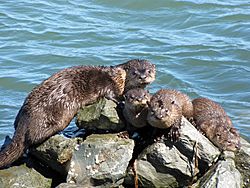
Aquatic mammals recently re-colonizing the Bay Area include the California golden beaver (Castor canadensis) which is now established on Alhambra Creek in Martinez, Napa River and Sonoma Creek; and North American river otter (Lontra canadensis) which was first reported in Redwood Creek at Muir Beach in 1996, and recently in Corte Madera Creek, and in the south Bay on Coyote Creek, as well as in 2010 in San Francisco Bay itself at the Richmond Marina. Sea otter (Enhydra lutris) were hunted to extinction in San Francisco Bay by about 1817. Historical records reveal that the Russian-American Company snuck Aleuts into San Francisco Bay multiple times, despite the Spanish capturing or shooting them while hunting sea otters in the estuaries of San Jose, San Mateo, San Bruno and around Angel Island. The founder of Fort Ross, Ivan Kuskov, finding otter scarce on his second voyage to Bodega Bay in 1812, sent Russian ships and hired an American ship to hunt otter in the Bay, catching 1,160 sea otter in three months.
Humphrey the Whale, a humpback whale (Megaptera novaeangliae), entered San Francisco Bay twice on errant migrations, and was successfully rescued and redirected each time in the late 1980s and early 1990s. This occurred again with Dawn and Delta a mother and calf in 2007.
Bottlenose dolphins and harbor porpoises have recently returned to the bay, having been absent for some 50 years. Historically, this was the northern extent of their warm-water species range. However, human development adversely impacted this habitat and pushed the species south to Monterey Bay. It is thought that laws limiting water pollution have improved the ecosystem health, allowing the return of cetacean marine life.
Birds of the Bay Area
Western burrowing owls (Athene cunicularia) were listed as a species of special concern (a pre-listing category under the Endangered Species Act) by the California Department of Fish and Game in 1979. California's population declined 60% from the 1980s to the early '90s, and continues to decline at roughly 8% per year. In 1994, the U.S. Fish and Wildlife Service nominated the western burrowing owl as a Federal Category 2 candidate for listing as endangered or threatened, but loss of habitat continues due to development of the flat, grassy lands used by the owl. A 1992–93 survey reported no breeding burrowing owls in Napa, Marin, and San Francisco counties, and only a few in San Mateo and Sonoma. The Santa Clara County population is declining and restricted to a few breeding locations, leaving only Alameda, Contra Costa, and Solano counties as the remnant breeding range. Despite organized protests at Kiper Homes' Blue Ridge property in Antioch, California by Friends of East Bay Owls, one-way doors were installed in the birds' burrows so that the owl families could not return to their nests in early 2010. In addition, in 2008, Mountain View, California evicted a pair of burrowing owls so that it could sell a parcel of land to Google to build a hotel at Shoreline Boulevard and Charleston Road. Eviction of the owls is controversial because the birds regularly reuse burrows for years, and there is no requirement that suitable new habitat be found for the owls.
In March, 2012 a bald eagle (Haliaeetus leucocephalus) nest was reported on the northwest arm of Lower Crystal Springs Reservoir and upper San Mateo Creek. This is the first bald eagle breeding pair on the San Francisco Peninsula since 1915, when they nested in La Honda, almost one hundred years ago. The birds were once common in the Bay Area. While visiting Santa Clara County in 1855, physician naturalist James G. Cooper described "a nest of this bird large enough to fill a wagon, built in a large sycamore tree, standing alone in the prairie. Habitat destruction and thinning of eggs from (now banned) DDT poisoning reduced the California state population to 35 nesting pairs at their lowest point. In the 1980s re-introductions began with the Santa Cruz Predatory Bird Research Group and the San Francisco Zoo began importing birds and eggs from Vancouver Island and northeastern California in the late 1980s.
Joseph Grinnell wrote in 1927 that osprey (Pandion haliaetus) were only rare visitors to the San Francisco Bay Area, although he noted records of one or two used nests in the broken tops of redwood trees along the Russian River. In 1989, the southern breeding range of the osprey in the Bay Area was Kent Lake, although osprey were noted to be extending their range further south in the Central Valley and the Sierra Nevada. However, in 2014 a Bay Area-wide survey found osprey had extended their breeding range southward with nesting sites as far south as Hunters Point in San Francisco on the west side and Hayward on the east side. Most nests were built on man-made structures close to areas of human disturbance, likely due to lack of mature trees near the Bay. Transfer of these birds to artificial nesting boxes away from human disturbance significantly increased nesting success. The above 2014 survey omitted nesting sites in Santa Clara County in the Los Gatos Creek watershed photographed as early as 2004, indicating that the nesting range now includes the entire length of San Francisco Bay.
The wild turkey population has increased greatly since their introduction during the ’60s and ’70s from other areas by game officials. By 2015 they had become an everyday sight in the East Bay Area.
Geology and landforms

Multiple terranes
The area is well known worldwide for the complexity of its landforms, the region being composed of at least six terranes (continental, seabed, or island arc fragments with distinct characteristics) pushed together over many millions of years by the forces of plate tectonics. Nine out of eleven distinct assemblages have been identified in a single county (Alameda). Diverse assemblages adjoin in complex arrangements due to offsets along the many faults (both active and stable) in the area. As a consequence, many types of rock and soil are found in the region. Formations include the sedimentary rocks of sandstone, limestone, and shale in uplifted seabeds, metamorphic serpentine rock, coal deposits, and igneous forms such as basalt flows, rhyolite outcroppings, granite associated with the Salinian Block west of the San Andreas Fault, and ash deposits of extinct yet relatively recently active (10 million years) volcanos. Pleistocene-era fossils of mammals are abundantly present in some locations.
Vertical relief
The region has considerable vertical relief in its landscapes that are not in the alluvial plains leading to the bay or in inland valleys. In combination with the extensive water regions this has forced the fragmented development of urban and suburban regions and has led to extensive building on poor soils in the limited flatland areas and considerable expense in connecting the various subregions with roads, tunnels, and bridges.
Several mountains are associated with some of the many ridge and hill structures created by compressive forces between the Pacific Plate and the North American plate. These provide spectacular views (in appropriate weather) of large portions of the Bay Area and include Marin County's Mount Tamalpais at 2,571 feet (784 m). Contra Costa County's Mount Diablo at 3,849 feet (1,173 m), Alameda County's Mission Peak at 2,517 to 2,604 feet (767 to 776 m), and Santa Clara County's Mount Hamilton at 4,213 ft (1,284 m), the latter with significant astronomical studies performed at its crowning Lick Observatory. Though Tamalpais and Mission Peak are quite lower than the others, Tamalpais has no other peaks and few hills nearby. Mission Peak is coast facing and is an interior mountain and therefore has excellent views of both sides.
The three major ridge structures (part of the Pacific Coast Range) which are all roughly parallel to the major faults:
- The Santa Cruz Mountains along the San Francisco Peninsula and the Marin Hills in Marin County (San Andreas Fault)
- The Berkeley Hills, San Leandro Hills and their southern ridgeline extension through Mission Peak (Hayward Fault)
- The Diablo Range, which includes Mount Diablo and Mount Hamilton (Calaveras Fault)
Major waterways
- San Joaquin River
- Sacramento River
- Napa River
- Suisun Marsh
- Sonoma Creek
- Guadalupe River
- Coyote Creek
- Petaluma River
- San Pablo Creek
- Wildcat Creek
- Oakland Estuary
- Russian River
- San Lorenzo River
- San Lorenzo Creek
- Gulf of the Farallones
- Alameda Creek
Earthquake faults
The region is also traversed by six major slip-strike fault systems with hundreds of related faults, many of which are "sister faults" of the infamous San Andreas Fault, all of which are stressed by the relative motion between the Pacific Plate and the North American Plate or by compressive stresses between these plates. The fault systems include the Hayward Fault Zone, Concord-Green Valley Fault, Calaveras Fault, Clayton-Marsh Creek-Greenville Fault, and the San Gregorio Fault. Significant blind thrust faults (faults with near vertical motion and no surface ruptures) are associated with portions of the Santa Cruz Mountains and the northern reaches of the Diablo Range and Mount Diablo.
Natural hazards
Earthquakes
The region is particularly exposed to hazards associated with large earthquakes. Two of the largest earthquakes in the area were the 1906 San Francisco earthquake and the 1989 Loma Prieta earthquake. The hazard from earthquakes is high in the Bay Area owing to a combination of factors:
- Numerous major active faults in the region.
- A combined thirty-year probability of a major earthquake in excess of seventy percent.
- Poorly responding native soil conditions in many places near the bay and in inland valleys, soils which amplify shaking as shown in the map to the right.
- Large areas of filled marshlands and bay mud that are significantly urbanized, with most subject to soil liquefaction, becoming unable to support structures.
- A large inventory of older buildings, many of which are expected to perform poorly in a major earthquake.
- Extensive building in areas subject to landslide, mudslide, and in some locations directly over active fault surface rubble zones.
- Most lowrise construction is not fireproof and water systems are likely to be extensively damaged and so large areas are subject to destruction by fire after a large earthquake.
- The coastal location makes the region vulnerable to Pacific Ocean tsunamis.
Some of these hazards are being addressed by seismic retrofitting, education in household seismic safety, and even complete replacement of major structures such as the eastern span of the San Francisco–Oakland Bay Bridge.
For an article concerning a typical fault in the region and its associated hazards see Hayward Fault Zone.
Flooding
Some flooding occurs on local drainages under sustained wet conditions when the ground becomes saturated, more frequently in the North Bay area, which tends to receive substantially more rainfall than the South Bay. In one case, the Napa River drainage, floodplain developments are being purchased and removed and natural wetlands restored in the innovative Napa River Flood Project as the previous channelization of insufficient capacity around such developments was causing flooding problems upstream. Many of the local creeks have been channelized, although modern practice, and some restoration work includes returning the creeks to a natural state with dry stormwater bypasses constructed to handle flooding. While quite expensive, the restoration of a natural environment is of high priority in the intensively urbanized areas of the region.
Windstorms and wildfires
Typically between late November and early March, a very strong Pacific storm can bring both substantial rainfall (saturating and weakening soil) and strong wind gusts that can cause trees to fall on power lines. Owing to the wide area involved (sometimes hundreds of miles of coast), electrical service can be interrupted for up to several days in some more remote localities, but service is usually restored quickly in urban areas. These storms occasionally bring lightning & thunder. More rarely they even spawn tornadoes. For example, during the abnormal hurricane-like storm in early 2010, a funnel cloud sparked an extremely rare Tornado Warning in Morgan Hill.
In the spring and fall, strong offshore winds periodically develop. These winds are an especially dangerous fire hazard in the fall when vegetation is at its driest, as exemplified historically by the 1923 Berkeley Fire and the 1991 Oakland Firestorm.
Mudslides and landslides
Some geologically unstable areas have been extensively urbanized, and can become mobile due to changes in drainage patterns and grading created for development. These are usually confined to small areas, but there have been larger problems in the Santa Cruz Mountains.
Transportation
Transportation in the San Francisco Bay Area is reliant on a complex multimodal infrastructure consisting of roads, bridges, highways, rail, tunnels, airports, ferries, and bike and pedestrian paths. The development, maintenance, and operation of these different modes of transportation are overseen by various agencies, including the California Department of Transportation (Caltrans), San Francisco Municipal Transportation Agency, and the Metropolitan Transportation Commission. These and other organizations collectively manage several interstate highways and state routes, two subway networks, three commuter rail agencies, eight trans-bay bridges, transbay ferry service, local bus service, three international airports (San Francisco, San Jose, and Oakland), and an extensive network of roads, tunnels, and paths such as the San Francisco Bay Trail.
The Bay Area hosts an extensive freeway and highway system that is particularly prone to traffic congestion, with one study by Inrix concluding that the Bay Area's traffic was the fourth worst in the world. There are some city streets in San Francisco where gaps occur in the freeway system, partly the result of the Freeway Revolt, which prevented a freeway-only thoroughfare through San Francisco between the San Francisco–Oakland Bay Bridge, the western terminus of Interstate 80, and the southern terminus of the Golden Gate Bridge (U.S. Route 101). Additional damage that occurred in the wake of the 1989 Loma Prieta earthquake resulted in freeway segments being removed instead of being reinforced or rebuilt, leading to the revitalization of neighborhoods such as San Francisco's Embarcadero and Hayes Valley. The greater Bay Area contains the three principal north–south highways in California: Interstate 5, U.S. Route 101, and California State Route 1. U.S. 101 and State Route 1 directly serve the traditional nine-county region, while Interstate 5 bypasses to the east in San Joaquin County to provide a more direct Los Angeles–Sacramento route. Additional local highways connect the various subregions of the Bay Area together.
There are over two dozen public transit agencies in the Bay Area with overlapping service areas that utilize different modes, with designated connection points between the various operators. Bay Area Rapid Transit (BART), a heavy rail/metro system, operates in five counties and connects San Francisco and Oakland via an underwater tube. Other commuter rail systems link San Francisco with the Peninsula and San Jose (Caltrain), San Jose with the Tri-Valley Area and San Joaquin County (ACE), and Sonoma with Marin County (SMART). In addition, Amtrak provides frequent commuter service between San Jose and the East Bay with Sacramento, and long-distance service to other parts of the United States. Muni Metro operates a hybrid streetcar/subway system within the city of San Francisco, and VTA operates a light rail system in Santa Clara County. These rail systems are supplemented by numerous bus agencies and transbay ferries such as Golden Gate Ferry and the San Francisco Bay Ferry. Most of these agencies accept the Clipper Card, a reloadable contactless smart card, as a universal electronic payment system.
Culture
The Bay Area is host to numerous cultural events, including annual festivals and fairs. Many prominent writers make their homes there, and have developed a local literary culture, with a supportive network of booksellers, focused on the Northern California Independent Booksellers Association.
Art
Sports
| Team | Sport | League | Venue |
|---|---|---|---|
| San Jose Earthquakes | Soccer | Major League Soccer | Avaya Stadium |
| San Francisco 49ers | Football | National Football League – National Conference | Levi's Stadium |
| Oakland Raiders | Football | National Football League – American Conference | O.co Coliseum |
| San Francisco Giants | Baseball | Major League Baseball – National League | AT&T Park |
| Oakland Athletics | Baseball | Major League Baseball – American League | O.co Coliseum |
| Golden State Warriors | Basketball | National Basketball Association | Oracle Arena |
| San Jose Sharks | Ice hockey | National Hockey League | SAP Center at San Jose |
| San Francisco Nighthawks | Soccer | Women's Premier Soccer League | Kezar Stadium |
| San Jose Giants | Baseball | Minor League Baseball – California League | San Jose Municipal Stadium |
- NCAA Division I College Sports
- California Golden Bears (FBS)
- Saint Mary's College Gaels
- San Francisco Dons
- San Jose State Spartans (FBS)
- Santa Clara Broncos
- Stanford Cardinal (FBS)
Motorsports
- Also, Infineon Raceway (Sonoma, California) is a motorsport track which currently hosts NASCAR Sprint Cup Series and IndyCar Series races.
Music
Classic rock
San Francisco proper was headquarters for the hippie counterculture of the 1960s and the music scene that became associated with it. One of the area's most notable acts was The Grateful Dead, formed in 1965, who played regularly at the legendary venue The Fillmore Auditorium. Other local artists in that movement included Jefferson Airplane and Janis Joplin; all three would be closely associated with the 1967 Summer of Love. Jimi Hendrix, although born in Seattle and later a resident of London, England, had strong connections to the movement and the metropolitan Bay area, as he lived in Berkeley for a brief time as a child and played many local venues in that decade. Creedence Clearwater Revival (of El Cerrito) would gain traction as an associated band of the anti-Vietnam war movement. Rock and Roll Hall of Fame legend Neil Young has lived in the Bay Area in La Honda, CA for more than 40 years. Carlos Santana from San Francisco became famous in the late 1960s and early 1970s with his Santana band which pioneered a blend of rock, salsa, and jazz fusion. Journey formed in 1973 in San Francisco, by former members of Santana. The Doobie Brothers, from San Jose, had a successful career with several albums earning RIAA gold certification. The early 1970s sounds of the Tower of Power from Oakland, Sly and the Family Stone and Pablo Cruise all came from the Bay Area.
Heavy metal
During the 1980s and early 1990s, the Bay Area was home to one of the largest and most influential thrash metal scenes in the world, containing acts like Metallica (although Metallica had initially formed in Los Angeles, it was not until their relocation to El Cerrito in 1983 that Cliff Burton and Kirk Hammett joined as bassist and lead guitarist), Exodus, Laaz Rockit, Death Angel, Vio-lence, Forbidden, and Testament.
Many death metal bands had also formed in the area, including Autopsy, Possessed (considered one of the first in the genre), and in the '90s, Impaled, Exhumed and Vile.
Also, an avant-garde metal scene has emerged in the Bay Area with bands such as Giant Squid, Grayceon, and Ludicra.
Sludge band Neurosis and groove metal/post-thrash bands Machine Head and Skinlab formed in Oakland. In the alternative metal and nu metal scenes worldwide, Faith No More (from San Francisco) and Primus (from El Sobrante, and featuring former Possessed guitarist Larry LaLonde) have been considered progenitors to both subgenres.
Heavy metal/hard rock icon Joe Satriani also hails from the Bay Area (Berkeley).
Alternative rock
Many bands of the 1990s post-grunge era started and still reside in the Bay Area, including Third Eye Blind (of San Francisco), Counting Crows (of Berkeley) and Smash Mouth (of San Jose), all of whom have received extensive radio play across the world and released multi-platinum records during their career.
Punk
The Bay Area saw a large punk movement from the 1970s to the present. Bands such as the Dead Kennedys, The Avengers, Flipper, D.R.I., M.D.C. and Operation Ivy were popular in the '70s and '80s, with later bands such as Rancid, Green Day and AFI all coming out of Berkeley. The Dwarves are residents of San Francisco, and are considered to be pioneers of the punk and hardcore movement.
Rap and hip hop
The Bay Area is the home of the hyphy movement, which started in the early to mid-'90s. The genre which was pioneered by rappers Andre "Mac Dre" Hicks, Too Short, Keak Da Sneak, Mistah Fab, E-40, DJ King Assassin and Yukmouth, is now becoming more popular throughout the world. Hyphy themes such as ghost riding, thizzin' and going dumb are now common in other parts of the country. The Bay Area was also home to rap legend Tupac Shakur who lived in Marin City, about 5 miles (8.0 km) north of San Francisco. The rap group Digital Underground originally hailed from Oakland. MC Hammer, and the Hieroglyphics hip hop crew, which is composed of local artists including the Souls of Mischief and Del tha Funkee Homosapien. Cindy Herron of En'Vogue attended Balboa High School in the late 1970s.
Media
The Bay Area is one of the largest media markets in the United States.
According to Nielsen Media Research, the Bay Area ranks (as of the 2005–2006 television season) as the nation's sixth-largest "Designated Market Area (DMA)", with 2,355,740 "TV Homes", representing 2.137% of the United States Total.
The major newspapers are the San Francisco Chronicle and the San Jose Mercury News. Local television channels include KTVU 2 (FOX), KRON-TV 4 (myNetworkTV), KPIX 5 (CBS), KGO-TV 7 (ABC), KQED-TV 9 (PBS), KNTV 11 (NBC), KBCW 44/45 (CW), KQEH 54 (PBS), and KKPX 65 (Ion). Radio stations serving the area include: KQED-FM, KMVQ, KOSF, and KGO-AM.
Regional counties, cities, and suburbs
Counties
- Alameda County (737 sq. mi., excluding water)
- Contra Costa County (720 sq. mi., excluding water)
- Marin County (520 sq. mi., excluding water)
- Napa County (754 sq. mi., excluding water)
- San Francisco County (47 sq. mi., excluding water)
- San Mateo County (449 sq. mi., excluding water)
- Santa Clara County (1,291 sq. mi., excluding water)
- Solano County (829 sq. mi., excluding water)
- Sonoma County (1,576 sq. mi., excluding water)
Cities and towns
- List of cities and towns in the San Francisco Bay Area
Economy
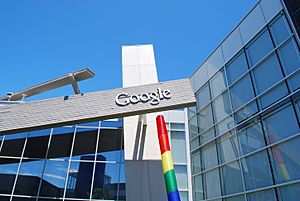
The three principal cities of the Bay Area represent different employment clusters and are dominated by different, but commingled, industries. San Francisco is home to the region's financial industry, tourism, and is host to numerous conventions. The East Bay, centered around Oakland, is home to heavy industry, metalworking, oil, and shipping, while San Jose is the heart of Silicon Valley where a major pole of economic activity around the technology industry resides. Furthermore, the North Bay is a major player in the country's agriculture and wine industry. In all, the Bay Area is home to the second highest concentration of Fortune 500 companies, second only to the New York metropolitan area, with thirty such companies based throughout the region. In 2019, the greater fourteen-county statistical area had a GDP of $1.086 trillion, the third-highest among combined statistical areas. The smaller nine-county Bay Area had a GDP of $995 billion in the same year, which nonetheless would rank it fifth among U.S. states and 17th among countries.
Several major corporations are headquartered in the Bay Area. Among the Fortune 500 companies located in the region include technology companies Google, Facebook, Apple Inc., Hewlett Packard, Intel, Adobe Inc., Applied Materials, eBay, Cisco Systems, Symantec, Oracle, Netflix, Sony Interactive Entertainment, Electronic Arts, and Salesforce; energy companies Chevron and PG&E; financial service companies Charles Schwab Corporation, Visa Inc., and Wells Fargo; apparel retailers Gap Inc., Levi Strauss & Co., and Ross Stores; aerospace and defense contractor Lockheed Martin; local grocer Safeway; pharmaceutical company McKesson; and biotechnology companies Genentech and Gilead Sciences. The largest manufacturers include Tesla Inc., Lam Research, Bayer, Chevron, and Coca-Cola. The Port of Oakland is the fifth-largest container shipping port in the United States, and Oakland is also a major rail terminus. In research, NASA's Ames Research Center and the federal research facility Lawrence Livermore National Laboratory are based in Mountain View and Livermore respectively. In the North Bay, Napa and Sonoma counties are known for their famous wineries, including Fantesca Estate & Winery, Domaine Chandon California, and D'Agostini Winery.
Despite the San Francisco Bay Area's booming industries contributing to the aforementioned economic growth, there is a significant level of poverty in the region. Rising housing prices and gentrification in the San Francisco Bay Area are often framed as symptomatic of high-income tech workers moving in to previously low-income, underserved neighborhoods. As of June 2014, median rent in San Francisco increased to $2,300, a 21% in one year. In Oakland, median rent increased by one-third between 2011 and 2013. Two notable policy strategies to prevent eviction due to rising rents include rent control and subsidies such as Section 8 and Shelter Plus Care. Moreover, in 2002, then San Francisco Supervisor Gavin Newsom introduced the "Care Not Cash" initiative, diverting funds away from cash handouts to housing. This proved controversial, with some suggesting his rhetoric criminalized poverty, while others supporting the prioritizing of housing as a solution. To this day, the effectiveness of Care Not Cash continues to be debated.
Contrary to historical patterns of low incomes within the inner city, poverty rates in the Bay Area are shifting such that they are increasing more rapidly in suburban areas than in urban areas. It is not yet clear whether the suburbanization of poverty is due to the relocation of poor populations or shifting income levels in the respective regions. However, the mid-2000s housing boom encouraged city dwellers to move into the newly cheap houses in suburbs outside of the city, and these suburban housing developments were then most impacted by the 2008 housing bubble burst. As such, people in poverty experience decreased access to transportation due to underdeveloped public transport infrastructure in suburban areas. Suburban poverty is most prevalent among Hispanics and Blacks, and affects native-born people more significantly than foreign-born.
As greater proportions of incomes are spent on rent, many impoverished populations in the San Francisco Bay Area also face food insecurity and health setbacks.
Sports and recreation
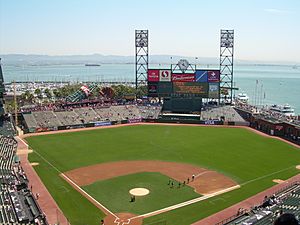
The Bay Area is home to six professional major league sports franchises: The San Francisco 49ers of the National Football League (NFL) in American football, the San Francisco Giants and Oakland Athletics of Major League Baseball (MLB), the Golden State Warriors of the National Basketball Association (NBA), the San Jose Sharks of the National Hockey League (NHL), and the San Jose Earthquakes of Major League Soccer (MLS).
In football, the 49ers play in Levi's Stadium and have won five Super Bowls (XVI, XIX, XXIII, XXIV, XXIX) and lost two (XLVII and LIV).
In baseball, the Giants, who play at Oracle Park, have won eight World Series titles, three since relocating to San Francisco (2010, 2012, and 2014) from New York in 1958. The A's, who play at the Oakland Coliseum, have won nine World Series titles, four since relocating to Oakland (1972, 1973, 1974, and 1989) from Kansas City in 1968.
In basketball, the Warriors play at the Chase Center and have won five NBA Finals, four since relocating to the Bay Area (1975, 2015, 2017, and 2018) from Philadelphia in 1962.
In hockey, the Sharks play at the SAP Center. They made their first Stanley Cup Finals appearance in 2016 but have not won the Stanley Cup.
In soccer, the Earthquakes play at Avaya Stadium and have won the MLS Cup twice in 2001 and 2003.
Outside of major league sports, the Bay Area is home to three minor league franchises. In hockey, the San Jose Barracuda play in the American Hockey League (AHL) and are the top affiliate of the San Jose Sharks, sharing the same rink at the SAP Center in San Jose. In baseball, the San Jose Giants in the California League of Minor League Baseball (MiLB) are the Low-A affiliate of the San Francisco Giants, playing out of the San Jose Municipal Stadium. In soccer, the Oakland Roots in the USL Championship, the second division of American soccer, currently play at Laney Field at Laney College.
In terms of collegiate sports, six Bay Area universities are members of NCAA Division I, the highest level of college sports in the country. All three football-playing schools in the Bay Area are in the Football Bowl Subdivision, the highest level of NCAA college football. The California Golden Bears and Stanford Cardinal compete in the Pac-12 Conference, and the San Jose State Spartans compete in the Mountain West Conference. The Cardinal and Golden Bears are intense rivals, with their football teams competing annually in the Big Game for the Stanford Axe. One of the most famous games in the rivalry occurred in 1982, when the Golden Bears defeated the Cardinal on a last-second return kickoff known as "The Play".
The Bay Area has an ideal climate for outdoor recreation, such that activities like hiking, cycling and jogging are popular among locals. There are more than 200 miles (320 km) of bicycle paths, lanes and bike routes just within San Francisco, and the Embarcadero and Marina Green are favored sites for skateboarding. Extensive public tennis facilities are available in Golden Gate Park and Dolores Park, as well as at smaller neighborhood courts throughout the city. San Francisco residents have often ranked among the fittest in the U.S. Boating, sailing, windsurfing and kitesurfing are among the popular activities on San Francisco Bay, and the city maintains a yacht harbor in the Marina District. The St. Francis Yacht Club and Golden Gate Yacht Club are located in the Marina Harbor, while the South Beach Yacht Club is located next to Oracle Park. The Bay Area was host to the 2013 America's Cup.
Education
Colleges and universities
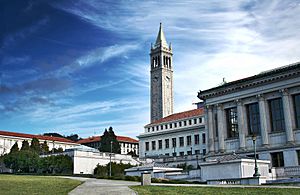
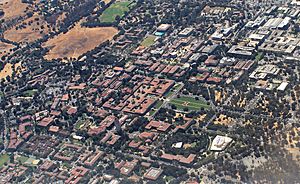
The Bay Area is home to a large number of colleges and universities. The three most notable universities are Stanford University, University of California, Berkeley, and University of California, San Francisco, all considered among the most prestigious universities in the world. The first institution of higher education in the Bay Area, Santa Clara University, was founded by Jesuits in 1851, who also founded the University of San Francisco in 1855. San Jose State University was founded in 1857 and is the oldest public college on the West Coast of the United States. According to the Brookings Institution, 45% of residents of the two-county San Jose metro area have a college degree and 43% of residents in the five-county San Francisco metro area have a college degree, the second and fourth highest ranked metro areas in the country for higher educational attainment.
Rankings compiled by U.S. News & World Report feature several Bay Area universities in prominent spots. Stanford University is the highest ranked university in the Bay Area, and seventh overall in the United States. The University of California, Berkeley is ranked twentieth overall, but for the past nineteen years has been highest-ranked public university in the country. Additionally, San Jose State University and Sonoma State University were respectively ranked sixth and tenth among public colleges in the West Coast.
The city of San Francisco is host to two additional University of California schools, neither of which confer undergraduate degrees. The University of California, San Francisco is entirely dedicated to graduate education in health and biomedical sciences. It is ranked among the top five medical schools in the United States and operates the UCSF Medical Center, which is the highest-ranked hospital in California. The University of California, Hastings College of the Law, founded in Civic Center in 1878, is the oldest law school in California and claims more judges on the state bench than any other institution. The city is also host to a California State University school, San Francisco State University. Additional campuses of the California State University system in the Bay Area are Cal State East Bay in Hayward and Cal Maritime in Vallejo.
California Community Colleges System also operates a number of community colleges in the Bay Area. According to CNNMoney, the Bay Area community college with the highest "success" rate is De Anza College in Cupertino, which is also the tenth-highest ranked in the nation. Other relatively well-ranked Bay Area community colleges include Foothill College, City College of San Francisco, West Valley College, Diablo Valley College, and Las Positas College.
Many scholars have pointed out the overlap of education and the economy within the Bay Area. According to multiple reports, research universities such as Stanford University, University of California - Santa Cruz and University of California - Berkeley, are essential to the culture and economy in the area. These universities also provide countless, public programs for people to learn and enhance skills relevant to the local economies. These opportunities not only provide educational services to the community, but also generate significant amounts of revenue.
Primary and secondary schools
Public primary and secondary education in the Bay Area is provided through school districts organized through three structures (elementary school districts, high school districts, or unified school districts) and are governed by an elected board. In addition, many Bay Area counties and the city of San Francisco operate "special service schools" that are geared towards providing education to students with handicaps or special needs. An alternative public educational setting is offered by charter schools, which may be established with a renewable charter of up to five years by third parties. The mechanism for charter schools in the Bay Area is governed by the California Charter Schools Act of 1992.
According to rankings compiled by U.S. News & World Report, the highest-ranked high school in California is the Pacific Collegiate School, located in Santa Cruz and part of the greater Bay Area. Within the traditional nine-county boundaries, the highest ranked high school is KIPP San Jose Collegiate in San Jose. Among the top twenty high schools in California include Lowell High School in San Francisco, Monta Vista High School in Cupertino, Lynbrook High School in San Jose, the University Preparatory Academy in San Jose, Mission San Jose High School in Fremont, Oakland Charter High School in Oakland, Henry M. Gunn High School in Palo Alto, and Saratoga High School in Saratoga.
Images for kids
-
A map of the locally accepted nine-county definition of the Bay Area. Also displayed are the five subregions of the Bay Area, which are divided along county lines except for the northwestern portion of Santa Clara county.
-
An early sketch of the Ohlone people dancing in Mission San Jose. The Ohlone lived in the Bay Area when European colonizers first arrived in the region.
-
The Bay Area, like all of California, was a part of Mexico until 1846, when John Berrien Montgomery captured San Francisco during the Mexican–American War and raised the American flag over Portsmouth Square.
-
Discovery of gold near Sutter's Mill transformed the Bay Area, which saw a flood of immigrants seeking wealth and hoping to strike it rich.
-
Damaged buildings in the aftermath of the 1906 San Francisco earthquake
-
U.S. President Harry S. Truman addressing the United Nations Conference in San Francisco that established the United Nations.
-
Mounted policeman observe a protest march against the Vietnam War in San Francisco in 1967.
-
2017 Women's March in Oakland. Other political rallies were held on the same day in numerous other locations throughout the Bay Area to spotlight progressive political causes and oppose Trump's presidency.
-
Satellite photo of the Bay Area taken in March 2019. The gray areas are signs of urbanization and represent the most populated areas.
-
A map of the water features in the San Francisco Bay Area, including the bay and adjacent marshes, ponds, and tributaries
-
Dense Infrastructure in Downtown San Francisco
-
Pixar, whose animated films have won numerous Academy Awards, is based in Emeryville.
-
The Berkeley Repertory Theatre is one of the founding members of Theatre Bay Area and is based in a building (pictured above) in downtown Berkeley.
-
Sutro Tower, the landmark TV and radio antenna tower in San Francisco where some of the major Bay Area stations transmit from
See also
 In Spanish: Área de la Bahía de San Francisco para niños
In Spanish: Área de la Bahía de San Francisco para niños










